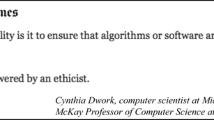Abstract
This article applies tools from argumentation theory to slippery slope arguments used in current ethical debates on genetic engineering. Among the tools used are argumentation schemes, value-based argumentation, critical questions, and burden of proof. It is argued that so-called drivers such as social acceptance and rapid technological development are also important factors that need to be taken into account alongside the argumentation scheme. It is shown that the slippery slope argument is basically a reasonable (but defeasible) form of argument, but is often flawed when used in ethical debates because of failures to meet the requirements of its scheme.



Similar content being viewed by others
Notes
Here is a simplified version of the definition given in the FDA guidelines. The term somatic cell therapy refers to the administration of living non-germline cells to humans from the same individual or from the same or different species, other than transfusable blood products, for therapeutic, diagnostic, or preventive purposes www.fda.gov/…/Guidances/CellularandGeneTherapy/ucm072987.htm.
It may be questionable however whether the assumption that germline genetic engineering could succeed in identifying gene loci that could be manipulated so as to increase characteristics like personal strength, intelligence or beauty. Because most genes serve multi-purposes in development it appears unlikely that, for example, intelligence could be increased without introducing serious effects on other gene-controlled characteristics.
References
Barry, V. E. (1976). Practical logic. New York: Holt, Rinehart and Winston.
Bashford, A., & Levine, P. (2010). Introduction: Eugenics and the modern world. In A. Bashford & P. Levine (Eds.), The Oxford handbook of the history of eugenics (pp. 3–24). Oxford: Oxford University Press.
Beardsley, M. C. (1966). Thinking straight. Englewood Cliffs: Prentice-Hall.
Bench-Capon, T. J. M., & Dunne, P. E. (2002). Value based argumentation frameworks, Technical report: http://intranet.csc.liv.ac.uk/research/techreports/tr2002/ulcs-02-001.pdf.
Corner, A., Hahn, U., & Oaksford, M. (2011). The psychological mechanism of the slippery slope argument. Journal of Memory and Language, 64, 133–152.
Galton, F. (1869). Hereditary genius. London: Macmillan.
Gardner, W. (1995). Can human genetic enhancement be prohibited? The Journal of Medicine and Philosophy, 20, 65–84.
Holtug, N. (1993). Human gene therapy: Down the slippery slope. Bioethics, 7(5), 402–419.
Hook, S. (1970). The paradoxes of freedom. Berkeley: University of California Press.
Hurley, P. (1982). A concise introduction to logic. Belmont: Wadsworth.
Kneale, W., & Kneale, M. (1962). The development of logic. Oxford: Oxford University Press.
Launis, V. (2002). Human gene therapy and the slippery slope argument. Medicine, Health Care and Philosophy, 5(2), 169–179.
Lifton, R. J. (1986). The Nazi doctors: Medical killing and the psychology of genocide. New York: Basic Books.
Macagno, F., & Walton, D. (2014). Emotive language in argumentation. Cambridge: Cambridge University Press.
Resnik, D. (1994). Debunking the slippery slope argument against human germ-line gene therapy. The Journal of Medicine and Philosophy, 19(1), 23–40.
Rizzo, M. J., & Whitman, D. C. (2003). The camel’s nose in the tent: Rules, theories and slippery slopes. UCLA Law Review, 51, 539–592.
Saliger, F. (2007). The dam burst and slippery slope argument in medical law and medical ethics. Zeitschrift fur Internationale Strafrechtsdogmatik, 9, 341–352.
Schauer, F. (1985). Slippery slopes. Harvard Law Review, 99(2), 361–383.
Van der Burg, W. (1991). The slippery slope argument. Ethics, 102, 42–65.
Walton, D. (1992). Slippery slope arguments. Oxford: Oxford University Press.
Walton, D. (2015). The basic slippery slope argument. Informal Logic, 35(3), 273–311.
Walton, D., Reed, C., & Macagno, F. (2008). Argumentation schemes. Cambridge: Cambridge University Press.
Acknowledgements
I would like to thank The Social Sciences and Humanities Research Council of Canada for Insight Grant 435-2012-0104 that supported the work in this paper, and acknowledge my indebtedness to the four very helpful referees who provided me with many detailed constructive criticisms, insightful comments, and corrections.
Author information
Authors and Affiliations
Corresponding author
Rights and permissions
About this article
Cite this article
Walton, D. The Slippery Slope Argument in the Ethical Debate on Genetic Engineering of Humans. Sci Eng Ethics 23, 1507–1528 (2017). https://doi.org/10.1007/s11948-016-9861-3
Received:
Accepted:
Published:
Issue Date:
DOI: https://doi.org/10.1007/s11948-016-9861-3




